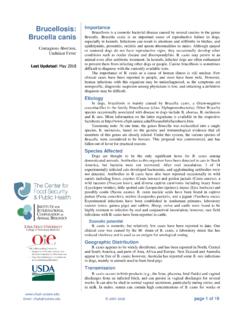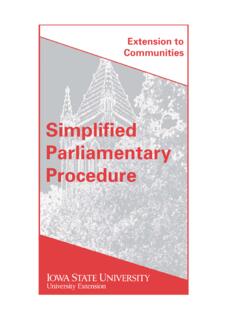Transcription of Corn and soybean response to soil pH level and liming
1 2011 Integrated Crop Management Conference - iowa State university 93. Corn and soybean response to soil pH level and liming Antonio P. Mallarino, professor, Agronomy, iowa State university ; Agustin Pagani, graduate research assistant, Agronomy, iowa State university ; John E. Sawyer, professor, Agronomy, iowa State university Soil pH and crop yield Limestone application to raise soil pH is needed when the pH is too acidic to allow for optimum crop growth and yield. Some iowa soils are naturally acidic, and others become acidic over time mainly due to sustained N application for corn with urea or ammonium-based products that acidify soils during the microbial transformation of ammonium to nitrate (nitrification). Soil pH decreases as the acidity increases because the pH measurement expresses acidity as the negative logarithm of H+ ion concentration.
2 Alfalfa is the most sensitive crop to low pH grown in iowa , while forage grasses are the least sensitive and corn and soybean are intermediate. Soil acidity can affect plant growth directly or indirectly by affecting the plant-availability of several nutrients, increasing levels of some elements to phytotoxic concentrations, and influencing microbial activity or other soil properties. Soil particles have the capacity to hold exchangeable H+ ions (often referred to as reserve acidity) in much higher concentrations that the concentrations of H+ in the soil solution. The amount of reserve acidity depends largely on the soil pH and clay and organic matter concentrations. Soil pH is and should be used to determine whether a soil is too acidic and requires liming , but pH by itself does not indicate the quantity of active or reserve acid that needs to be neutralized and the amount of lime to apply.
3 In iowa and most states , the amount of lime needed to increase soil pH to a desirable level is estimated by mixing a strong buffer solution of known pH with soil and measuring the resulting pH. change. Low buffer pH values indicate high reserve acidity and higher lime requirement, and research with different soils and pH values are used to determine the lime requirement to raise pH to a certain value. A few states use some indicators such as pH, texture, and/or organic matter instead of buffer pH, while a few others use buffer pH together with some of these soil properties. Current pH and lime management guidelines for corn and soybean The current iowa State university (ISU) soil pH and lime application guidelines (extension publication PM 1688) have not changed in the past 30 years (Sawyer et al.)
4 , 2002). For most iowa soils, the guidelines suggest lime application for grass hay or pastures, corn or soybean , and alfalfa when soil pH is < , < , and < , respectively. A pH of is considered sufficient for corn and soybean in regions with high-pH (calcareous) subsoil, however, although when the soil is to be limed the suggestion is to apply the amount of lime needed to raise pH to pH These regions include the soil association areas Clarion-Nicollet-Webster in north-central iowa (the Des Moines Lobe) and Galva-Primghar- Sac, Moody, Ida-Monona, Marshall, and Luton-Onawa-Salix in western iowa . These guidelines were based on research conducted during the 1960s through the late 1970s using many lime application rates, mainly by ISU researchers Drs. John Hanway, John Webb, and Dr. John Pesek. The information used to develop the guidelines is largely unpublished or was summarized in partial annual progress reports of ISU research farms or other brief reports.
5 A summary for long-term experiments with corn and soybean on acid soils at the Moody and northeast research farms and two other short-term experiments in Crawford and Plymouth counties (Voss, 1991) showed clear responses at the extreme northwest (Moody) and northeast iowa sites, but small and erratic responses at the western iowa sites. Early progress reports for a long-term experiment with continuous corn established by Drs. Webb and Pesek in the early 1960s in a Webster soil having slightly acid surface soil (pH of ) and calcareous subsoil at the Northern research farm showed very small or no yield response to annual small rates of lime (225 to 900 lb CCE/acre). A summary of an experiment Dr. Webb conducted with corn- soybean rotations in acid soils northwest research farm (Mallarino, 1991, unpublished) indicated moderate yield responses to lime, and a slightly higher relative response from soybean than from corn.
6 More recent research has shown variable corn and soybean responses to lime across iowa soils having average pH. as low as to ; which has generated questions about optimum pH values for these crops and how appropriate are the current lime application guidelines. An on-farm study conducted from 1998 to 2000 evaluated uniform and variable-rate lime application for corn and soybean in two central iowa fields having soils with high-pH subsoil 94 2011 Integrated Crop Management Conference - iowa State university (Bianchini and Mallarino, 2002). They found a small yield increase only for corn in one year at one field. Dr. Stanley Henning conducted long-term experiments with corn and soybean from the late 1980s to the middle 2000s at three ISU research farms. He found no yield responses at the Armstrong (southwest) research farm where soils have high- pH subsoil (Henning, 2007), small or no responses at the southeast research farm in a soil without high-pH subsoil (Henning, 2004), and large responses at the northeast research farm in a soil with no high-pH subsoil (Henning, 2001, 2004, 2008).
7 Summaries of the most recent years of the long-term study with continuous corn and annual lime rates at the northern research farm showed small and statistically not significant yield corn response to lime (Mallarino and Rueber, 2003). A long-term experiment conducted from the middle 1990s to the middle 2000s at the northwest research farm (Kassel, 2004) evaluated different rates of lime for corn- soybean rotations managed with different tillage systems. This is a region classified as having high-pH subsoil, and they reported small to moderate yield responses from soybean but no response from corn. Results of two recent studies that compared aglime and eggshells in the northern and northwest research farms (both areas being classified as having high-pH subsoil) showed small soybean yield increases at the northwest farm but no corn yield increases at any location (Holmes et al.)
8 , 2011). In recent years, questions also have been raised by laboratories about buffer pH methods to determine lime requirement that do not include chemicals classified as hazardous by EPA. The method that has been used in iowa and most Corn Belt states for decades (Shoemaker-McLean-Pratt, or SMP buffer) includes such chemicals, and makes the test for lime requirement more expensive due to EPA disposal regulations. Therefore, there is interest in comparing new buffer pH methods in iowa soils, such as the Mehlich and Sikora buffer methods because they do not include hazardous chemicals, but no research has been conducted in iowa to evaluate these methods. The Mehlich buffer pH method should not be confused with the Mehlich-3 extractant used for phosphorus (P), potassium (K), and other nutrients. Objectives of new research An on-farm research project was initiated in 2007 with corn and soybean to address several of the questions indicated above.
9 The objectives were to (1) study within-field soil pH and buffer pH variability, (2) compare the new buffer pH. methods Mehlich, Sikora, and the the currently used SMP method for estimating lime requirement, and (3) study the variation of crop response to lime within fields and re-evaluate soil pH values currently considered optimum for corn and soybean in some important iowa soils. Summary of procedures for on-farm strip trials Fourteen strip trials were established staggered over three years to avoid applying lime the same year in all trials. The first crop year was 2007 with five trials, 2008 with five other trials, and 2009 with four trials. All trials will be evaluated across four years. Therefore, the trials currently have been evaluated four, three, and two years for the trials established in 2007, 2008, and 2009, respectively.
10 Results for yield and soil pH for the 2011 crop year were not available when this article went to print, and results for the last year of four trials will not be available until late fall 2012. Two aglime treatments were no aglime and 3 ton of Effective Calcium Carbonate Equivalent (ECCE)/acre applied only once before the first corn or soybean crop. Most fields were managed with corn- soybean rotations, but some farmers planted two years of corn in a few fields. The treatments were replicated 4 to 5 times with the only exception of one narrow and long field where only two replications fit when borders were excluded. The trials were in Boone, Cedar, Crawford, Greene, Jasper, O'Brien, Pottawattamie, Ringgold, Story, and Union counties. Management practices other than lime application were those used by each farmer.









